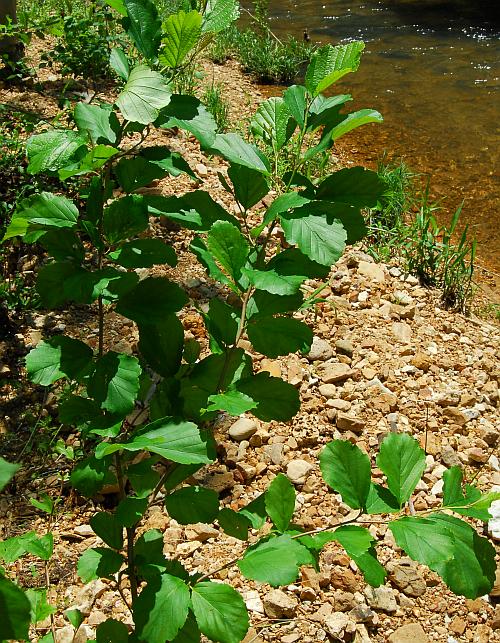Hamamelis vernalis Sarg.
Ozark Witch-Hazel

Native
CC = 7
CW = 0
MOC = 30
© SRTurner
Hamamelis vernalis Sarg.Ozark Witch-Hazel | |
 |
Native CC = 7 CW = 0 MOC = 30 |
© SRTurner |
|
Family - Hamamelidaceae Habit - Shrubs to 4 m tall, spreading by woody underground runners.
Stems - Twigs moderately to densely stellate-hairy.
Leaves - Alternate, simple, pinnately veined, the margins coarsely toothed or with shallow rounded lobes, turning yellow to brown in autumn but generally persisting through the winter. Petioles 3-15 mm long. Leaf blades 7-12 cm long, 5.5-8.0 cm wide, elliptic or obovate, the base obtuse to rounded, weakly to moderately asymmetrical, sometimes narrowly cordate on one side and narrowed on the other, the tip rounded or broadly and bluntly pointed, the undersurface often glaucous.
Inflorescences - Axillary stalked clusters of mostly 3 flowers apiece.
Flowers - Perfect, strongly fragrant. Calyx 3-4 mm long, hemispherical, 4-lobed, brown, densely stellate-hairy, often persistent at fruiting. Petals 4, 10-15 mm long, narrowly strap-shaped, yellow, orange, or red. Stamens 4, alternating with 4 inconspicuous scalelike staminodes, the filaments short and broad, the anther sacs separated by broad connecting tissue. Styles curved outward or reflexed, persistent on the fruit as short beaks. Ovules 1 per locule.
Fruits - Capsules, 9-16 mm long, woody, brown, dehiscing explosively longitudinally along the midnerve of each locule, persistent long after the seeds are dispersed. Seeds 2 per fruit, 5-10 mm long, narrowly elliptic to oblong-elliptic in outline, black with a light colored attachment scar toward the base, shiny, not winged.
Flowering - January - April. Habitat - Rocky streambanks, bases of wooded slopes. Origin - Native to the U.S. Lookalikes - H. virginiana. Other info. - This is consistently the first native plant to flower in early spring ... or even late winter. Under favorable conditions, a warm, sunny, late winter day will trigger massive flowering, with thousands of blooms filling the air with a sweet floral scent. Indeed, the flowering plants are often first detected by their fragrance. Insect pollinators are generally not abundant at this early time of year, but the flowers nevertheless attract small gnats and flies. Photographs taken at Pea Ridge Conservation Area, Washington County, MO, 2-6-2012, 2-11-2013, 7-11-2018, and 2-23-2020, Carman Springs Natural Area, Howell County, MO, 5-14-2019, and at Little Indian Creek Conservation Area, Franklin County, MO, 3-3-2025 (SRTurner). |